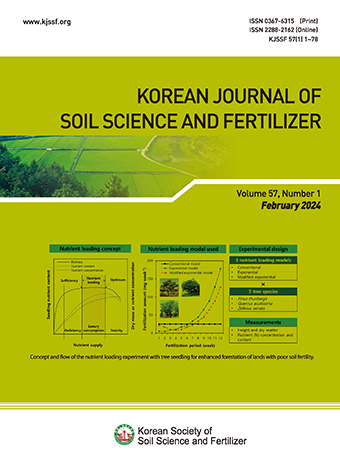Original research article
Abstract
References
Information
Groenenberg, J.E., P.F.A.M. Römkens, R.N.J. Comans, J. Luster, T. Pampura, L. Shotbolt, E. Tipping, and W. De Vries. 2010. Transfer functions for solid-solution partitioning of cadmium, copper, nickel, lead and zinc in soils: derivation of relationships for free metal ion activities and validation with independent data. Eur. J. Soil Sci. 61(1):58-73.
10.1111/j.1365-2389.2009.01201.xKim, K.R., J.S. Park, M.S. Kim, N.I. Koo, S.H. Lee, J.S. Lee, S.C. Kim, J.E. Yang, and J.G. Kim. 2010. Changes in heavy metal phytoavailability by application of immobilizing agents and soil cover in the upland soil nearby abandoned mining area and subsequent metal uptake by red pepper. Korean J. Soil Sci. Fert. 43(6):864-871.
Norton, G.J., T. Dasgupta, M.R. Islam, S. Islam, C.M. Deacon, F.J. Zhao, J.L. Stroud, S.P. McGrath, J. Feldmann, A.H. Price, and A.A. Meharg. 2010. Arsenic influence on genetic variation in grain trace-element nutrient content in Bengal Delta grown rice. Environ. Sci. Technol. 44:8284-8288.
10.1021/es101487x21028809Prueb, A. 1997. Action values mobile (NH4NO3-extractable) trace elements in soils based on the German national standard DIN 19730. p. 415-423. In F. Arendt, G.J. Annokkee, R. Annokkee, W.J. Van den Brink (eds.) Contaminated Soils, 3rd International Conference on the Biogeochemistry of Trace Elements, Paris. Dordrecht: Kluwer Academic Publishers.
Sumner, M.E., and W.P. Miller. 1996. Cation exchange capacity and exchange coefficients. In D.L. Sparks, A.L Page, P.A. Helmke, R.H. Loeppert, P.N. Soltanpour, M.A. Tabatabai, C.T. Johnston and M.E. Sumner (ed.). Methods of soil analysis. 1201-1229. Part 3- Chemical method. SSSA and ASA, Madison, WI.
- Publisher :Korean Society of Soil Science and Fertilizer
- Publisher(Ko) :한국토양비료학회
- Journal Title :Korean Journal of Soil Science and Fertilizer
- Journal Title(Ko) :한국토양비료학회 학회지
- Volume : 53
- No :1
- Pages :41-49
- Received Date : 2020-02-05
- Revised Date : 2020-02-20
- Accepted Date : 2020-03-02
- DOI :https://doi.org/10.7745/KJSSF.2020.53.1.041



 Korean Journal of Soil Science and Fertilizer
Korean Journal of Soil Science and Fertilizer








